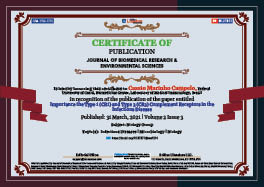> Biology Group. 2021 Mar 31;2(3):216-217. doi: 10.37871/jbres1214.
Importance the Type 1 (CR1) and Type 3 (CR3) Complement Receptors in the Infectious Disease
Cassio Marinho Campelo*
The complement system is one of the host’s primary defence mechanisms against pathogens. Its activation involves proteolytic cascades of enzymatic reactions that result in products with effector functions and recognition of molecules on the surface of microorganisms [1,2].
Complement activation depends on a proteolytic cascade of enzymatic reactions that result in products with effects function of molecules identification in microorganism surface for complement classical, alternative, and lectin pathways, converging to C3 complement central protein and formation of subproducts C3a and C3b [1,2].
The C3a subunit is a small fragment complement protein that promotes inflammation. The C3b subunit is an opsonin potent covalently binds to the microorganisms’ surface, signalizing mononuclear phagocytes recruitment, promoting the phagocytose, and activating the three complement pathways, and forms a Membrane Attack Complex (MAC) [1,2].
The complement receptors are cell-surface G Protein-Coupled Receptors (GPCRs) with distribution in innate and adaptative immune system cells. It binds for opsonized microorganisms facilitating recognition, capture, and internalization by the mononuclear phagocyte. They are structuraly diferentes [2,3].
Complement Receptor type 1 (CR1) is a polymorphic glycoprotein of the only chain, with 30 Complement Control Protein domains (CCPs), two interaction sites with high affinity to C3b and C4b complement subunit, responsible for decay C3 and C5 convertase, strong binding with C4b and higher binding with C3b [2,4].
CR1 is present on the surface of erythrocytes, monocytes, neutrophils, macrophages, lymphocytes. CR1 acts to regulate the complement cascade as a receptor for C3b and C4b subunit; he promotes the clearance of immune complex binding in erythrocyte surfaces; it is a receptor essential in the phagocytosis process for monocytes and neutrophils in inflammation, and it regulates the B lymphocytes between T lymphocytes response [2,4].
In autoimmune diseases and other inflammatory disorders, the CR1 expression modulates autoantibodies that cause accumulation of complex immune. While CR1 polymorphism in infectious disease has a consequence in the resistance Plasmodium falciparum infection in malaria and susceptibility HIV, increase viral replication in monocytes and lymphocyte T CD4 [5-9].
The modulation of expression CR1 in disease involves mechanisms with a difference in cytokine production for leucocytes, variation in the immune response, and changes in the inflammatory conditions of systemic form [2,4].
The Complement Receptor type 3 (CR3), also called Mac-1 and αMβ2, belong to the integrins family with different subunits with high binding to inactive complement fragment iC3b. CR3 is express in neutrophils, monocytes, macrophages, granulocytes, and NK cells. CR3 involves phagocytoses, adhesion cells, oxidative burst, leukocytes movement, and regulated inflammation process [2,4].
When a microorganism infects a host occur activation of phagocytic cells, migration cell process mediated for CR3. Phagocytic cells make capture and internalization of microorganisms used surface receptors. CR3 recognizes the opsonized pathogens by fragments C3 (C3b and iC3b), stimulating increased phagocytosis. The phagocytosis process decreased the complement receptor on the cell surface [2,4].
In leishmaniasis, the parasite uses the GP63 express in your membrane to cleavage fragment C3b to a fragment iC3b, destroying almost all your blinding sites present on C3b, and promoting increased adhesion cell in monocytes, neutrophils, and macrophages. The CR1 and CR3 expression modulation has a critical role in visceral leishmaniasis, causing severe clinical presentation [10].
The CR1 and CR3 complement receptors can be a biomarker to future research as targets to new drugs and understand pathogenesis in the infectious disease.
References
- Merle NS, Church SE, Fremeaux-Bacchi V, Roumenina LT. Complement System Part I - Molecular Mechanisms of Activation and Regulation. Front Immunol. 2015 Jun 2;6:262. doi: 10.3389/fimmu.2015.00262. PMID: 26082779; PMCID: PMC4451739.
- Bullard DC. The complement factsbook (second edition). 2018;435-450 doi: 10.1016/B978-0-12-810420-0.00041-9.
- Ahmadzai MM, Broadbent D, Occhiuto C, Yang C, Das R, Subramanian H. Canonical and Noncanonical Signaling Roles of β-Arrestins in Inflammation and Immunity. Adv Immunol. 2017;136:279-313. doi: 10.1016/bs.ai.2017.05.004. Epub 2017 Jun 17. PMID: 28950948.
- Ricklin D, Hajishengallis G, Yang K, Lambris JD. Complement: a key system for immune surveillance and homeostasis. Nat Immunol. 2010 Sep;11(9):785-97. doi: 10.1038/ni.1923. Epub 2010 Aug 19. PMID: 20720586; PMCID: PMC2924908.
- Ross GD, Yount WJ, Walport MJ, Winfield JB, Parker CJ, Fuller CR, Taylor RP, Myones BL, Lachmann PJ. Disease-associated loss of erythrocyte complement receptors (CR1, C3b receptors) in patients with systemic lupus erythematosus and other diseases involving autoantibodies and/or complement activation. J Immunol. 1985 Sep;135(3):2005-14. PMID: 4020137.
- Kumar A, Malaviya AN, Srivastava LM. Lowered expression of C3b receptor (CR1) on erythrocytes of rheumatoid arthritis patients. Immunobiology. 1994 Aug;191(1):9-20. doi: 10.1016/S0171-2985(11)80264-0. PMID: 7806259.
- Mouhoub A, Delibrias CC, Fischer E, Boyer V, Kazatchkine MD. Ligation of CR1 (C3b receptor, CD35) on CD4+ T lymphocytes enhances viral replication in HIV-infected cells. Clin Exp Immunol. 1996 Nov;106(2):297-303. doi: 10.1046/j.1365-2249.1996.d01-844.x. PMID: 8918576; PMCID: PMC2200595.
- Stoute JA. Complement receptor 1 and malaria. Cell Microbiol. 2011 Oct;13(10):1441-50. doi: 10.1111/j.1462-5822.2011.01648.x. Epub 2011 Aug 24. PMID: 21790941.
- Ueno N, Wilson ME. Receptor-mediated phagocytosis of Leishmania: implications for intracellular survival. Trends Parasitol. 2012 Aug;28(8):335-44. doi: 10.1016/j.pt.2012.05.002. Epub 2012 Jun 21. PMID: 22726697; PMCID: PMC3399048.
- Campelo CM, Pinheiro IC, de Melo Tavares B, Alves de Lima Henn G, Fernandes C, Albuquerque-Pinto LC, Carneiro Câmara LM. Modulation in the expression of type 1 (CR1/CD35) and type 3 (CR3/CD11b) complement receptors on leukocytes from patients with Visceral leishmaniasis. Exp Parasitol. 2020 Nov;218:107970. doi: 10.1016/j.exppara.2020.107970. Epub 2020 Aug 21. PMID: 32828829.
Content Alerts
SignUp to our
Content alerts.
 This work is licensed under a Creative Commons Attribution 4.0 International License.
This work is licensed under a Creative Commons Attribution 4.0 International License.








